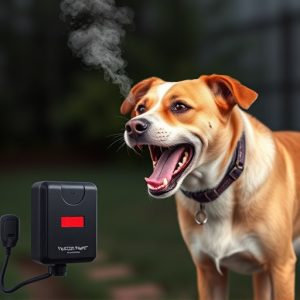Sonic Dog Repellents: Science, Safety, and Future Innovations Unveiled
Dog repellent devices using ultrasonic sound waves or scent-based technologies are gaining popularit…….
Dog repellent devices using ultrasonic sound waves or scent-based technologies are gaining popularity for urban animal control. These devices must undergo strict Dog Repellent Device Compliance Testing to ensure safety, effectiveness, and environmental responsibility. The testing evaluates sound intensity, frequency range, and scent concentration, protecting non-target species and humans. Sonic repel systems effectively deter dogs and cats through inaudible ultrasonic waves or pheromones, offering benefits in parks, public spaces, and residential neighborhoods. Future advancements aim to create humane, environmentally conscious solutions with sophisticated sensors and durable materials, all while adhering to stringent compliance standards.
“Unleashing a revolutionary approach to animal control, the Animal Control Sonic Repellent System offers an innovative solution for managing dog behavior. This comprehensive guide explores the potential of these devices, delving into their mechanism, effectiveness, and impact on various environments.
From understanding the science behind sonic repellents to examining compliance testing standards, we unravel the benefits and challenges of implementation. Additionally, we glimpse into the future of dog repellent technology, highlighting emerging innovations and considerations for an ever-evolving field.”
- Understanding Dog Repellent Devices and Their Role in Animal Control
- The Science Behind Sonic Repellents: How They Work
- Compliance Testing for Dog Repellent Devices: Ensuring Safety and Effectiveness
- Benefits and Challenges of Implementing Sonic Repellents in Various Environments
- Future of Dog Repellent Technology: Innovations and Considerations
Understanding Dog Repellent Devices and Their Role in Animal Control
Dog repellent devices have emerged as innovative tools in animal control, particularly for managing canine populations in urban areas. These devices utilize various technologies, such as ultrasonic sound waves or scent-based repellents, to deter dogs from specific locations. Understanding their functionality and effectiveness is crucial for responsible implementation. Compliance testing plays a vital role here, ensuring these dog repellent devices meet safety standards and comply with regulations.
By subjecting these devices to rigorous testing, manufacturers can prove their products’ reliability and efficiency in real-world scenarios. This process involves evaluating factors like sound intensity, frequency range, and scent concentration to guarantee they are humane and environmentally friendly. Effective compliance testing not only protects the public and pets from potential harm but also maintains a harmonious balance between urban development and wildlife conservation.
The Science Behind Sonic Repellents: How They Work
Sonic repel systems work by emitting high-frequency sound waves that are inaudible to humans but disruptive to animals, particularly dogs and cats. These ultrasonic frequencies, typically ranging from 25 to 64 kHz, stimulate the animal’s nervous system, causing them to feel discomfort or even pain. This reaction is similar to how humans might react to a high-pitched alarm or an irritant scent.
The technology has evolved significantly over time, with advanced devices incorporating multiple ultrasonic emitters and adjustable settings for different environments. Compliance testing plays a crucial role in ensuring these dog repellent devices meet safety standards and are effective without causing harm to non-target species or humans. Rigorous testing protocols assess the device’s performance, including its ability to repel animals, while also evaluating any potential acoustic impacts on the surrounding ecosystem.
Compliance Testing for Dog Repellent Devices: Ensuring Safety and Effectiveness
In recent years, there has been a growing interest in animal control sonic repellent systems, particularly for dog repellents. These devices use sound waves to deter dogs from entering specific areas, offering a non-lethal alternative to traditional methods. However, before such products can reach the market, they must undergo rigorous Dog Repellent Device Compliance Testing to ensure both safety and effectiveness. This testing is crucial in confirming that the devices do not pose harm to humans or other animals and that they truly serve their intended purpose.
The compliance testing process involves a series of detailed evaluations, including lab tests for sound output levels, durability assessments, and field trials to measure repellency rates under various conditions. These tests are designed to meet industry standards and regulations, ensuring that the dog repellent devices perform as advertised while adhering to safety guidelines. By subjecting these products to such thorough scrutiny, manufacturers can build consumer trust and guarantee their products’ quality, ultimately contributing to more effective and ethical animal control practices.
Benefits and Challenges of Implementing Sonic Repellents in Various Environments
Implementing sonic repellents as an animal control measure offers several benefits across diverse environments. These devices emit sound waves that are unpleasant or even painful to animals like dogs and cats, encouraging them to steer clear of treated areas. This non-lethal approach is particularly advantageous in urban settings where traditional methods might be met with resistance due to concerns over animal welfare and esthetic considerations. Sonic repellents can help maintain peace in parks, public spaces, and residential neighborhoods by preventing unwanted wildlife intrusions.
However, challenges exist when deploying these devices. Environmental factors such as wind and background noise can affect the effectiveness of sonic repellents. Additionally, compliance testing is crucial to ensure that these dog repellent devices operate within safe sound pressure levels, adhering to local regulations, especially in residential areas. The need for regular testing and potential adjustments underscores the importance of careful implementation to balance animal welfare with environmental harmony.
Future of Dog Repellent Technology: Innovations and Considerations
The future of dog repellent technology is an exciting prospect, with innovations that offer more effective and humane solutions for managing canine behavior. As research progresses, we can expect to see advanced devices that utilize a combination of ultrasonic sounds, pheromones, and smart sensors to target specific dogs while minimizing environmental impact. These technologies aim to address the growing demand for dog-friendly solutions without compromising public safety or causing distress to animals.
One key area of focus is the development of sophisticated sensor systems that can distinguish between different species and even individual dogs. This enables targeted repellents, ensuring that non-target animals, such as wildlife or pets from neighboring properties, are not affected. Moreover, with advancements in materials science, we may see the creation of longer-lasting and more durable dog repellent devices that undergo rigorous compliance testing to ensure they meet safety standards. These innovations aim to strike a balance between effective dog control and environmental sustainability.
The implementation of dog repellent devices, especially those utilizing sonic technology, presents a promising solution for animal control. Through understanding their scientific principles, rigorous compliance testing, and acknowledging both their benefits and challenges, we can effectively navigate the future of dog repellents. As technology advances, continuous innovation and careful consideration will ensure these devices meet safety standards while humanely addressing canine behavior issues across diverse environments.


